Picture this: You sign up for your favorite creator’s webinar. Two days later, you receive a personalized thank you note plus a special discount code for their course. A few days after that, you get a reminder to use the discount code plus an opportunity for a one-on-one chat with the creator.
What you’ve experienced is drip marketing. It’s a smart way for creators to stay top-of-mind with their audience and drive sales for their digital products. In this article, you’ll learn how to set up a successful drip marketing campaign that wins you new clients and revenue.
Skip ahead:
- What is drip marketing?
- Benefits of drip marketing campaigns
- Elements of drip marketing campaigns
- Types of drip marketing campaigns
- How to set up a drip marketing campaign
- Drip campaign marketing best practices
- Drip marketing frequently asked questions (FAQs)
What is drip marketing?
Drip marketing means sending automated email sequences to a target audience as part of a marketing campaign over a period of time. That’s a pretty high-level definition, so let’s break it down further.
A drip marketing sequence has a primary trigger — an action potential customers complete that adds them to an email list. It could be:
- Placing an order
- Signing up for a webinar
- Signing up for a service
- Downloading a lead magnet like an ebook or white paper
- Abandoning a shopping cart
- Engaging with customer service
Once on the list, the audience receives a series of pre-scheduled emails relevant to the marketing campaign’s goal. Say you’re pre-selling a course: the drip emails could explain the value subscribers will get from your course and share discount codes to encourage them to pre-order it.
You can further customize the sequence based on the subscribers’ actions. For example, you can share a poll with different pain points and ask subscribers to choose the one that affects them most — then send them hyper-specific emails based on their choice.
Drip emails are highly customizable, so you can choose how many emails you want to send and the times you want to send them. You could send one out right after a customer signs up for a free trial, welcoming them to your platform, and send another two days later giving them a few ideas on how to use the product. Then, send the final one the following week focused on the use case they chose during their onboarding process.
Now, that many email marketing tools are integrating artificial intelligence, you can use that feature for hyper-personalization and predictive analytics, which will help you tailor email content to each recipient.
Related: How to sell courses with email marketing
Benefits of drip marketing campaigns
Creators who implement drip marketing enjoy many benefits including:
-
Top-of-mind awareness
Top-of-mind awareness means you’re the first creator that comes to your audience’s mind when they think about the product or services in your niche. It makes it easier for you to attract and convert clients.
Drip marketing earns you top-of-mind awareness by continuously putting your brand in front of your target audience. Your audience learns more about your products or services with each email. They can even reach out to have one-on-one conversations to address their objections.
By the end of the email sequence, your audience will have a solid idea of the problem your product or service solves. Armed with this information, they can make a purchase or recommend your brand to people in their network looking for the solutions you offer.
-
Reduced lead decay
If you got a penny for every time you visited a website to buy a product but got distracted and forgot all about it, how rich would you be? For us, pretty rich!
No thanks to the internet’s many distractions, potential clients are always dropping off the buyer journey — meaning you’re repeatedly missing out on opportunities to earn money. However, with drip marketing, you can reconnect with lost leads and get them back into your client pipeline.
Drip marketing platforms let you track metrics like the number of subscribers who click the links in your emails. Say fifty subscribers click the purchase link but only twenty buy your product; you can track and send follow-up emails to those who didn’t complete the action.
-
Personalized marketing
People spend 38 percent more money when a brand delivers personalized customer experiences. Drip marketing helps you customize customer experience through hyper-specific segmentation.
You can categorize email subscribers into segments based on demographic information, behaviors, interests, and the like. This segmentation allows for highly targeted and personalized messaging, making the emails more relevant and valuable to each recipient.
You can also request additional data from your subscribers to further customize your messaging. For example, you can ask for their occupation or income level and send custom product offers that suit these characteristics.
Elements of drip marketing campaigns
A successful drip marketing campaign is made up of the following components:
-
Lead magnet
The lead magnet is the trigger that adds the target audience to the drip marketing sequence. It could be something like a webinar, an ebook, or a newsletter sign-up.
The target audience provides their email addresses to access the lead magnet. Completing this action automatically adds them to the drip marketing sequence.
-
Email sequences
An email sequence is a series of pre-scheduled messages sent to a specific audience over a specific period of time. It forms the core of your drip marketing campaign.
Say you’re planning a drip marketing campaign for your ebook; your email sequence might look like this:
Welcome email ➡️ Educational email related to the ebook ➡️ Second educational email ➡️ Preorder email with discount code ➡️ Second email with the same preorder code ➡️ free one-on-one session to resolve audience objections ➡️ Final email with discount code
-
Segmentation
Segmentation means categorizing people on your email list into sub-groups based on specific criteria like demographic information, interests, occupation, and actions.
To do segmentation right you need the right data. You can collect this info by adding segmentation criteria directly to your lead collection form. So if occupation is one of your segmentation criteria, just ask people to input their occupation when filling out the form.
With these pieces of data, you can automatically organize subscribers into specific segments in your drip marketing campaign tool and send personalized messages to match their pain points, needs, and expectations.
-
Automation
Imagine that you had 50,000 people on your email list and had to manually send emails to each one three times a day. That’s a literal nightmare! Thankfully, you don’t have to.
A drip marketing sequence is powered by automation. Once you’ve set up the campaign, the emails will go out to the right audience segments based on a predetermined schedule.
You can also use automation to guide the audience’s journey throughout the sequence. For example, you can set up behavior-based triggers based on subscriber actions. Say someone clicks on a specific link in an email; the action can then trigger a follow-up email with relevant content.
Related: How does marketing automation work?
-
Metrics
Tracking the right metrics allows you to know how well your drip marketing campaign is achieving its goals. Metrics such as open rates, click-through rates, conversion rates, and overall engagement provide valuable insights.
The metrics you track should add up to your overall marketing objective. Say your overarching marketing goal is to increase ebook purchases by 50 percent; one of your metrics can be click-through rate. You’ll use this to measure how many subscribers are clicking on the purchase link in your email to order the ebook.
Learn more: The ultimate guide to conversion rate optimization
Types of drip marketing campaigns
Marketers love drip marketing campaigns because they can be used for all sorts of purposes: welcoming new customers, converting free trial users to paid customers, reducing cart abandonment rates, re-engaging old customers, and more.
While the opportunities are endless with drip campaigns, most of them fit nicely into the following categories:
-
Welcome email drip
When someone ends up on your email list for whatever reason–be it downloading a report or signing up for your newsletter–it’s safe to assume that that’s the person’s time getting value from your brand. So the first thing to do is make them feel at home.
A welcome email drip is a great way to do that; it can help you make a stellar first impression and get new people just learning about your brand to see your value.
Here’s how Codecademy does it:
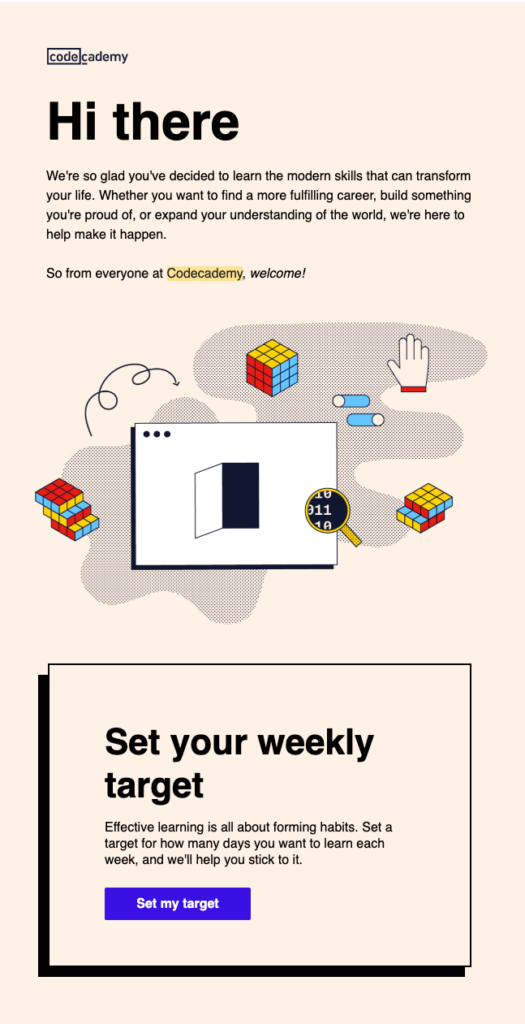
Notice how the company first expresses its excitement that I’ve signed up to the platform before telling me the value I can get from it: finding a more fulfilling career, building something I’m proud of, or expanding my understanding of the world. Once it has established what I can achieve, it shows me the first step: setting a weekly learning target.
There are many angles to take with welcome email drips, depending on how a person gets onto your email list. But whichever one you take, remember that welcome emails are primarily for thanking new subscribers for signing up to your email list and letting them know what kind of content they can expect from you in the future.
-
Onboarding email drip
While a welcome email is technically part of an onboarding email drip, this type of drip marketing campaign is often reserved for people who signed up for your product (as opposed to those who downloaded your free report or registered for a webinar).
The main goal of an onboarding email drip is to shorten the users’ time-to-value–the amount of time it takes them to derive value from your product or service. The emails you send should help them get familiar with your offering and guide them through the first steps they need to take to engage with your product/service fully.
Say, for example, a user has signed up for your project management platform. Your onboarding drip campaign could include:
- Email 1 (Welcome): Thank the user for signing up and provide links to their dashboard or key features.
- Email 2 (Getting Started guide): Share a tutorial on creating their first project or using a primary feature.
- Email 3 (Pro tips): Highlight more advanced features or integrations that improve productivity.
- Email 4 (Customer support and resources): Offer customer support contacts, link to FAQs, and encourage the user to reach out if they run into any problems.
Here’s an example from Dropbox:
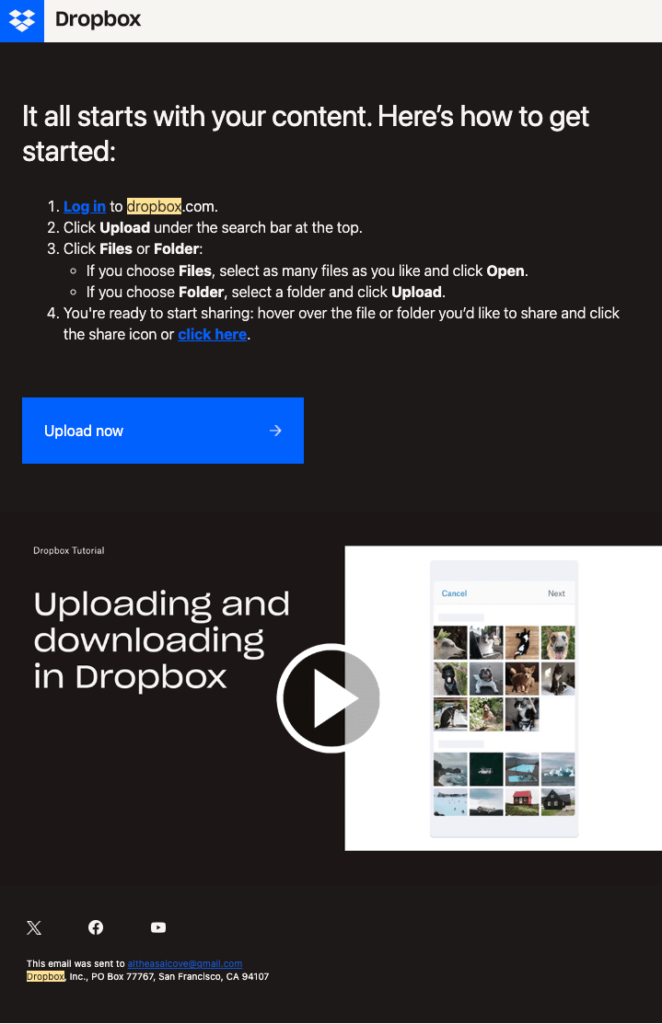
The subject line shows that this is the first of nine emails in Dropbox’s onboarding drip campaign. This email contains steps to take to upload and share a file or folder through Dropbox and an accompanying video tutorial on how to do that.
So, instead of tinkering with a tool whose interface I’m not familiar with, these steps and tutorial will make it easy for me to get started, thereby reducing the time it takes me to derive value from the platform.
-
Lead nurturing email drip
While some people who sign up for your newsletter or read your free eBook might sign up to use your platform immediately, not every lead does. Sometimes, you have to show them what they’re missing out on. Lead nurturing emails help you do that; their purpose is to help you build relationships with prospects at every stage of their buyer journey.
Suppose you run a company that offers online courses for marketing professionals, and someone downloads your free eBook. Your nurturing drip campaign could include:
- Email 1 (Thank you and next steps): Thank them for downloading the eBook and offer a brief introduction to related online courses.
- Email 2 (Educational blog post): Send an article or case study that aligns with the topic of the eBook they downloaded.
- Email 3 (Webinar invite): Invite them to an upcoming webinar where they can learn more and ask questions live.
- Email 4 (Customer testimonial): Share a success story from someone who took the course and saw results.
- Email 5 (Discount code or limited-time offer): Offer a discount to encourage them to enroll in the course.
Semrush sends me lead nurturing drips all the time. This one’s an invitation to attend a free webinar on how to boost local visibility, which is one of the goals that its ideal users want to achieve:
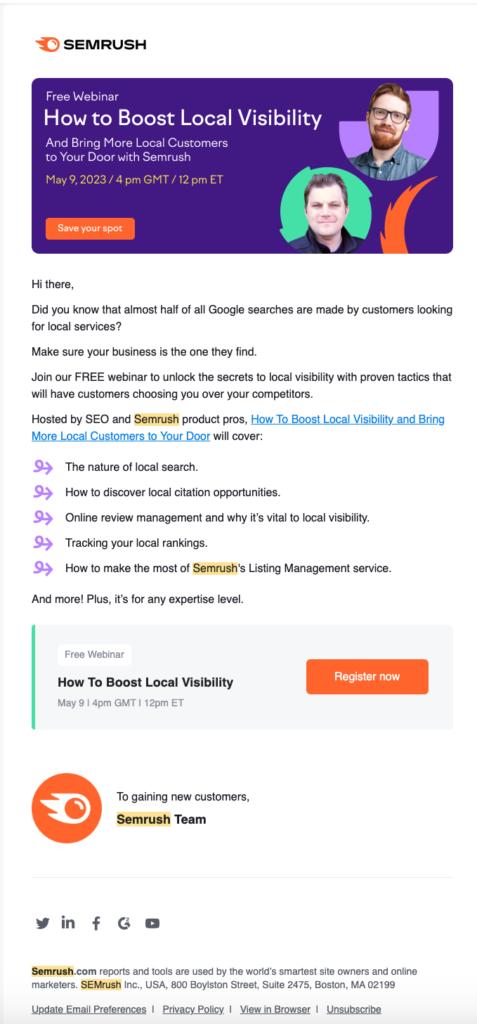
If I ran a business and was looking to improve my local visibility, I’d attend the webinar and might end up paying for the product. See how it works?
-
Abandoned cart email drip
Raise your hand if you’ve visited an online store and loaded up your cart only to get distracted by something and forget to pay. Well, this is more common than you think; in 2024, 70.19% of eCommerce customers abandoned their shopping carts. While some did so because they changed their minds, others might have simply forgotten to check out.
As a business owner, it’s disheartening to put so much into marketing only to realize that most people who added items to their shopping cart left your site without completing their purchase. But don’t panic–an abandoned cart email drip is exactly what you need to execute to remind them about their cart and encourage them to finalize their order.
Here’s how Rudy’s does it:
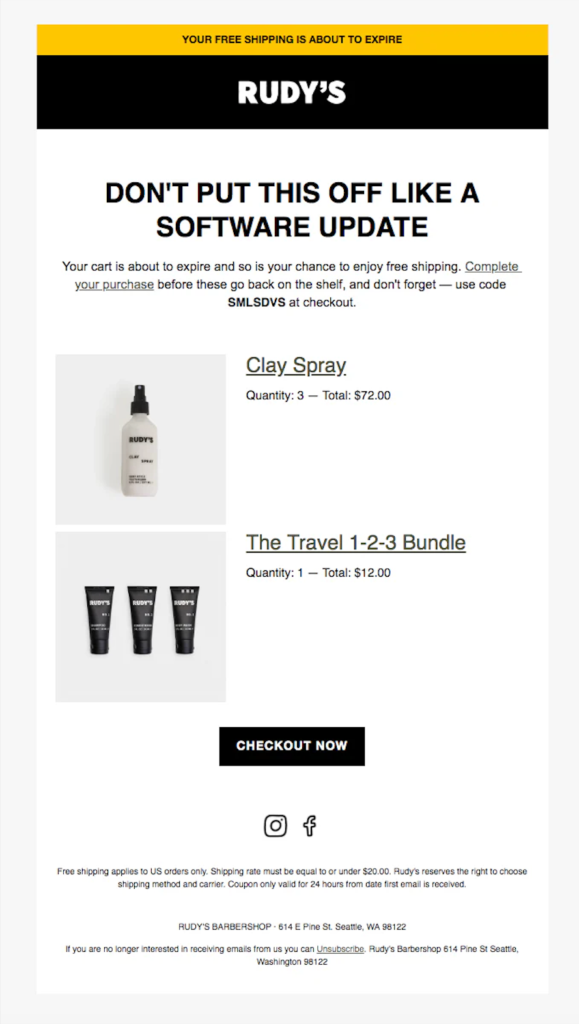
Understanding that the prospect might’ve been distracted during the buying process, Rudy’s uses some humor to convey its message: checkout now.
This is just the first email in a standard abandoned cart email drip, though. If the user doesn’t respond to this reminder, you can send other emails like:
- Email 2 (Product benefits): Highlight the benefits of the specific product they left behind, perhaps including a review or demo video.
- Email 3 (Discount offer): Offer a limited-time discount to incentivize them to complete the purchase, if applicable.
- Email 4 (Last call): Send a final reminder with a message like “Hurry, your cart items are almost gone!” or “Last chance to use your discount.”
-
Engagement email drip
As a business owner, you always want your customers to keep using your products and interacting with your brand. That’s why you keep producing content and making new product features, right?
People will only engage with your offerings if they know about them, so use an engagement email drip to tell them. Engagement emails keep your audience connected with your brand by providing relevant content, special promotions, or product updates. This is essential for nurturing ongoing relationships and keeping your brand top of mind.
Say, you own a fitness app. Here’s how you can use an engagement drip campaign to keep users engaged even after downloading the app:
- Email 1 (Content sharing): Send beginners a workout plan with tips on getting started.
- Email 2 (Progress reminder): Encourage users to track their progress or use specific app features to stay consistent.
- Email 3 (Special event): Invite them to participate in a fitness challenge or a virtual class.
- Email 4 (New feature announcement): Notify users about new tools, like meal planning features or integration with smart devices.
A good example of an engagement email is this one where Inkitt asks me to join its writing contests to create fantasy worlds or craft historical love stories.

Learn more: Ultimate guide to customer engagement: Strategies, tips, and tools
-
Re-engagement email drip
Duolingo uses an in-app feature called Streaks to keep users returning to the app daily. So if you miss a day of Spanish or French lessons, Duolingo will send you one of these:
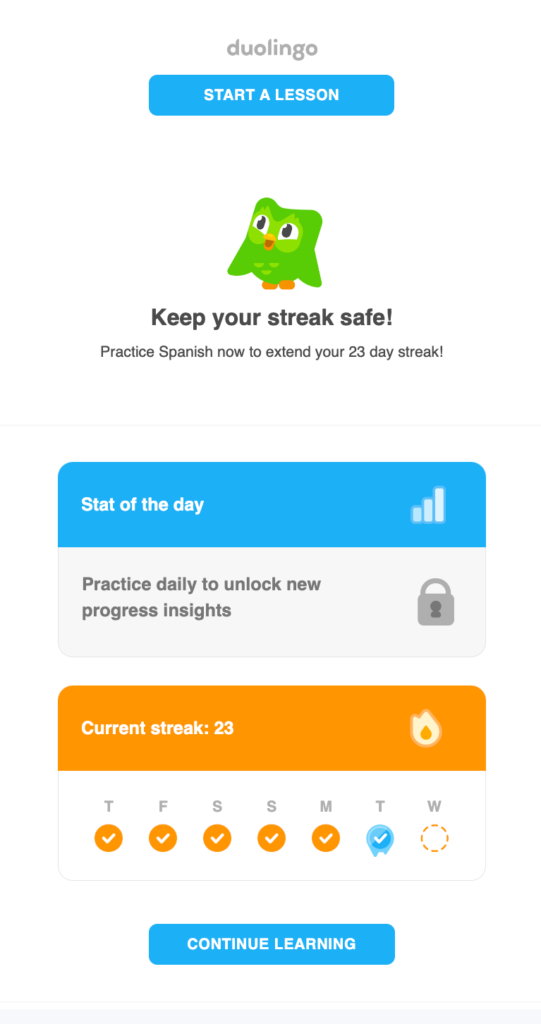
This email, asking me to take a Spanish lesson to keep my Streak safe, is the first of several emails in Duolingo’s re-engagement email drip.
Here’s another email after nine months of not using Duolingo:
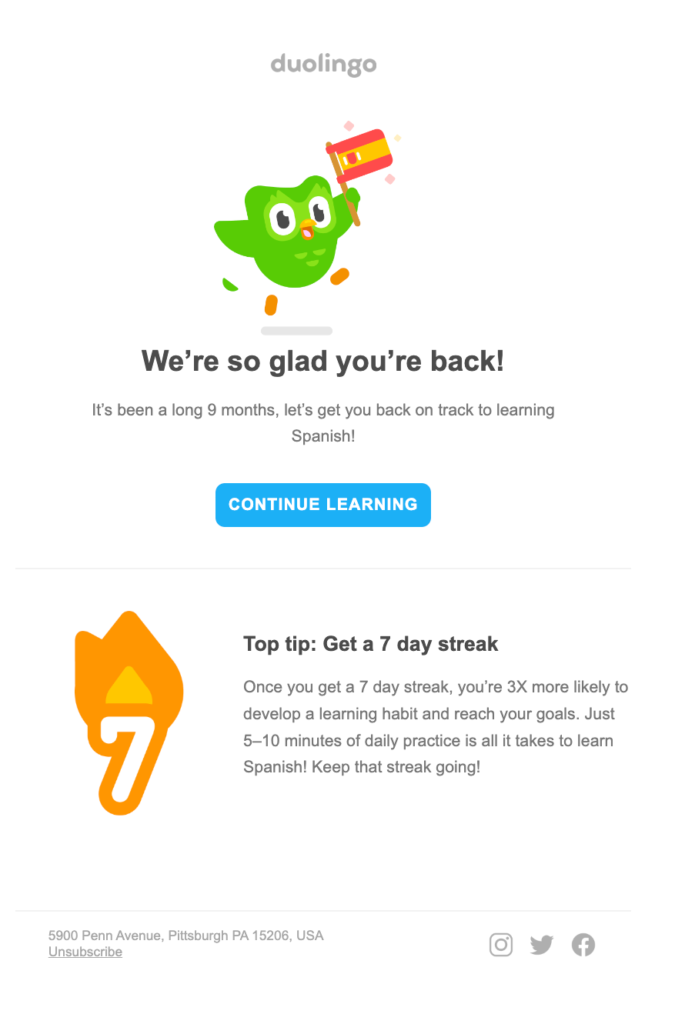
Notice how the drip cadence is spread out over time for nearly a year. Sometimes, it takes that long to get customers who haven’t interacted with your brand in a while to return. And yes, that email made me realize how long it’d been, so I went back to continue my Spanish lessons.
Re-engagement emails aim to revive interest and re-establish the relationship, whether that’s getting them back to using your product, making a purchase, or simply opening your emails again.
Pro tip: People like a great deal, so if you can, offer unengaged customers exclusive discounts or rewards if they return.
-
Product recommendations email drip
“You might also like:” is a common marketing tactic that many companies use to get you to buy more or use their service for longer. Here’s how Netflix does it:

Most eCommerce brands like Amazon and Walmart also send product recommendations to customers based on their past behaviors, such as previous purchases, browsing habits, or cart additions. This increases the chances of repeat purchases or upsell and cross-sell opportunities.
For example, if you own an online bookstore, you could send product recommendation emails to customers based on their past reading interests. The drip could include:
- Email 1 (Suggested reads): After purchasing a crime thriller, send the customer recommendations for similar books or bestsellers in the same genre.
- Email 2 (Discount offer): Offer a small discount on any of the recommended books.
- Email 3 (New arrivals): Notify the customer about new releases or upcoming pre-orders that match their interests.
-
Unsubscribe email drip
It feels like a gut punch when someone unsubscribes from your email list, especially knowing that the chances of them coming back are slim. But this can also serve as a learning moment that can help you improve your email marketing strategy–if you execute your unsubscribe email drip well.
Of course, you should try to get them to re-subscribe, but the main goal of the unsubscribe drip campaign is to learn why they left in the first place. So once someone clicks the unsubscribed link, politely confirm that they want to unsubscribe, thank them for being part of the email list, provide an optional link to manage preferences instead of fully unsubscribing (e.g., change email frequency or content types), and ask why they chose to unsubscribe.
The feedback they leave can help you know what to tweak to improve your email marketing performance (e.g., switching from three emails per week to two).
How to set up a drip marketing campaign
Now that you know what drip marketing is and its benefits, let’s explain how to set up a successful drip marketing campaign as a creator.
-
Set your marketing goal
Your marketing goal will define the scope and overall direction of your drip campaign. It acts as your campaign’s north star — without which everything will go awry.
Say your goal is to increase pre-orders for your digital product; your sequence will be salesy and include direct promotions like discount codes. On the other hand, if your goal is to drive traffic to your blog, your sequence will have high-value educational content and direct links to relevant blog posts.
Whatever your goal is, it must pass the SMART test. This means it should be specific, measurable, achievable, relevant and time-bound.
- Specific: The goal should be clear and leave no room for ambiguity, vagueness or misinterpretation. For example, don’t say, “I want to sell more digital products.” Say, “I want to sell fifty ebooks each month through email marketing.”
- Measurable: Add concrete criteria for measuring progress and determining when you have achieved the goal. For example, don’t say, “I want to increase sales.” Say, “I want to increase sales by 30 percent from 100 books per month to 130 books per month.”
- Achievable: Set a challenging but attainable goal — without that you’ll end up frustrated. Say you only sold 50 books per month in the past; your goal might be to sell 75 ebooks monthly — not 1000!
- Relevant: Your goal should tie to your overall business objectives. Say your priority is increasing mindshare; your drip campaign goal should then be to drive top-of-mind awareness, not sales.
- Time-bound: Set a specific timeframe for achieving your goal — like a month or quarter. This creates a sense of urgency and helps you stay focused on achieving the goal within a reasonable period.
Once you’ve set your goal, choose drip campaign metrics that add up to it. For example, if your goal is to sell 50 ebooks per month, click through and conversion rates can be your email marketing metrics.
-
Choose your drip campaign marketing platform
Your drip marketing campaign platform is where you’ll set up your sequence, track delivery, and measure results at the end of your campaign, o you need to get it right — mistakes in the set up can easily ruin your sequence and compromise your results.
There are three big things to consider when choosing a drip marketing platform: ease of use, support for segmentation, and personalization and integrations. Let’s discuss them further.
Ease of use
Choose a drip campaign tool that you can set up independently with little or no coding requirements. At the very least, you should be able to implement basic automations in the tool without technical help.
As a creator, the last thing you want is to get stuck in the middle of a campaign because you need some complex HTML to create a simple customization sequence in your email software.
Support for segmentation and personalization
Choose a drip marketing software that lets you set up hyper-specific segmentations for your email list. For example, you should be able to create customized sequences based on demographic information.
With better segmentation, you can deliver personalized messages to your audience, build stronger engagement, and increase their chances of buying your digital product or taking some other desired action.
Integrations
Your drip marketing software should easily integrate with the other tools you use for your business — so it’s easier to move data around. For example, it should sync with your customer relationship management software (CRM) and e-learning platform so you can share subscribers’ data to and from these tools.
Thinkific, for example, integrates with top drip marketing software on the market including ActiveCampaign and ConvertKit to make it easier for you to manage clients’ information from a central platform.
-
Categorize your target audience into segments
Drip marketing is about sending personalized messages relevant to specific audience segments. The easiest way to segment your audience is through demographic information.
Add demographic information fields to your lead collection form and save the data to your drip marketing software. Next, set up personalized messages for each segment. Let’s say location is one of your segmentation criteria: you can send a parity pricing discount code to subscribers in a specific location.
Beyond demographic data, you can segment your audience based on their actions on your website or how they are added to the marketing sequence. For example, you can separate previous clients from people who are interacting with your brand for the first time.
Learn more: What is customer segmentation and how to do it right
-
Create your drip marketing content
Create compelling content that convinces the audience to take the desired action at different stages of your marketing sequence. There are three types of content you should prioritize for your drip marketing campaign:
Lead magnet
The lead magnet is a valuable resource your audience is willing to exchange their email for. It can be anything: from ebooks and white papers to webinars and exclusive podcasts with industry leaders.
When creating your lead magnet, remember only one rule: no fluff. If the audience discovers that your lead magnet is filled with irrelevant, generic information, they will unsubscribe from your email list — or worse — spread word to people in their network about their subpar experience with your brand.
Learn more: How to create a converting lead magnet
Subject lines and body copy
Your subject line is the first thing subscribers see when they receive your email. To a large extent, it determines whether they’ll open your email or condemn it to oblivion.
A good subject line is concise, unique and relevant to the email content. Generally, your subject line should have five to seven words or about 40 characters. It should be interesting enough to pique the reader’s interest and contain information that the main copy will expand on.
Consider the following example from Thinkific:

The subject is straight to the point and promises interesting information that prompts the reader to click the email.
The body copy should live up to the subject line’s promise — that is to explain the main point the subject highlights. Get personal here and lose the industry jargon. Write like you’re chatting with a friend in a coffee shop. But don’t get lost in lengthy dialogue — keep your copy between 50–125 words.
If you go over the recommended word count (it happens), break up your text with interesting visuals like images, illustrations and GIFs.
Call-to-action (CTA)
The CTA is the part of the email that encourages recipients to take a specific action, such as clicking on a link or buying your course.
An effective CTA is clear, creates a sense of urgency and stands out from the rest of your text. Here’s an example from Thinkific:
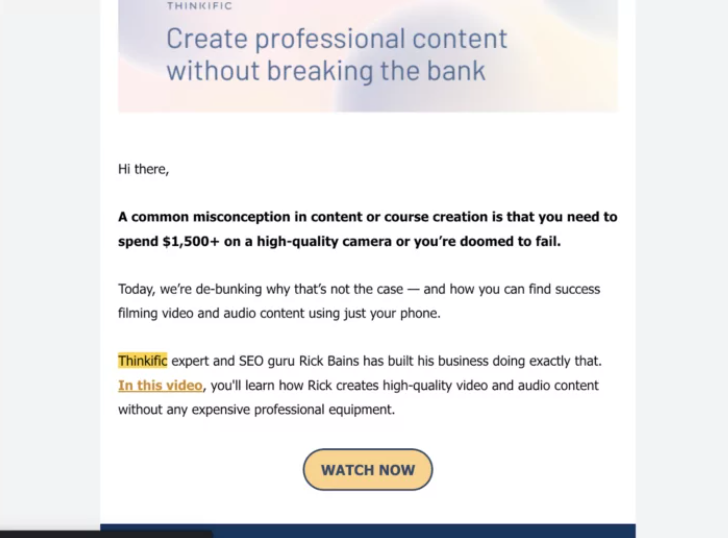
Notice how the CTA button has a different color from the rest of the text and there’s no other text around it? That’s how obvious your CTA should be.
For lengthy emails, place your call to action towards the beginning of your mail and also at the end of the body copy. That way, you’ll capture people who do not read the email to the end and the ones who do but may have forgotten the action you want them to take.
Learn more:15 call-to-action examples that convert
-
Create your drip marketing flowchart
A drip marketing flowchart is a visual representation of your drip marketing sequence. It shows the different triggers and customizations for your audience segments and how they move through the sequence until they complete the final action.
Visualizing your sequence lets you discover any loopholes or inconsistencies in your drip campaign. For example, you might find out that you need to add a new trigger to segment your audience further and customize your messaging better.
Creating a drip marketing flowchart has the potential to get overly complicated — soto keep things simple, follow these steps:
- Define your initial trigger; that is, what brings the audience into your sequence.
- Choose the primary channel for hosting your lead magnet. This can be your website or social media channels.
- List your audience segments. For example, segmentation by location or segmentation by gender
- Identify the triggers that will activate subsequent messages. Triggers can be time-based (e.g. every three days) or action-based (e.g. user clicks a link).
- Define the ultimate goal of the drip campaign, whether it’s to convert leads into customers, increase engagement, or achieve some other specific objective.
Say you’re creating a flowchart for pre-selling your ebook; it might look like this: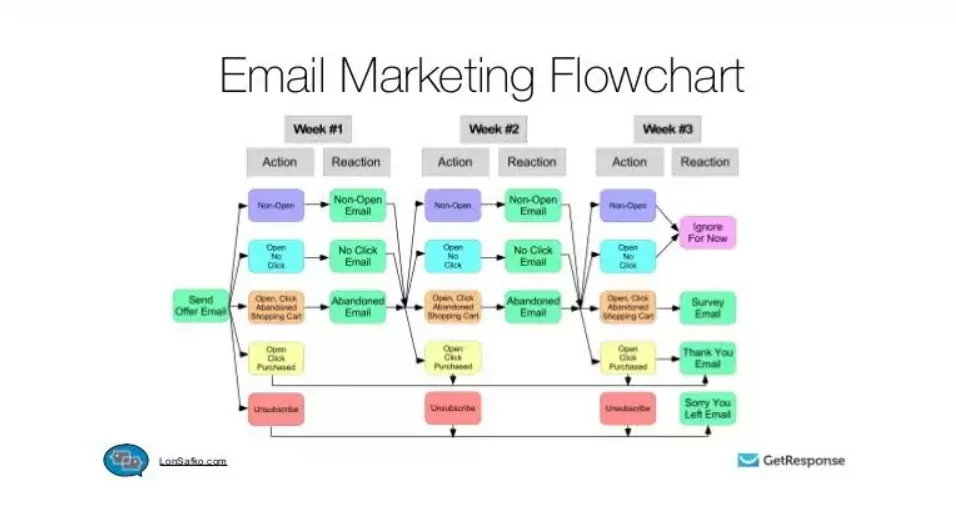
This flowchart becomes the blueprint for your drip marketing campaign. You’ll use it to set up your drip marketing sequence in your email software.
Drip campaign marketing best practices
To ensure the success of your drip marketing campaign, you must stick to certain best practices before, during, and after setting up your campaign. Here are some of them:
-
Segment your audience
A one-size-fits-all approach to drip campaign marketing is bound to fail because the people on your list are likely at different stages of the customer journey and have varied interests.
By dividing your email list into smaller groups based on shared characteristics, you can tailor messages to resonate with the specific needs of each group. There are two ways to segment your audience:
- Demographic segmentation. Segment by age, location, or gender to send personalized messages and product recommendations.
- Behavioral segmentation. Group email subscribers based on their actions, such as downloading a resource, purchasing a specific service, or clicking on a particular product page. For example, someone who abandoned their cart will need a different email series than a user who just signed up for a newsletter.
-
Personalize your emails
Personalization in drip marketing involves using subscriber data to craft emails that feel relevant and individualized. This can be as simple as addressing the recipient by name and sending them a birthday email, or as advanced as recommending products based on past behavior. Litmus’ 2024 State of Email report shows that over 80% of marketers saw some performance improvement when using subject line personalization and dynamic content personalization.
The integration of AI into email marketing tools makes personalization easier because AI can analyze large amounts of customer data–such as browsing behavior, purchase history, and engagement patterns–to tailor email content for each recipient.
AI can do things like:
- Dynamically change email content (such as subject lines, product suggestions, or CTAs) based on individual recipient data;
- Recommend specific products based on a user’s past purchases or browsing activity; and
- Analyze a user’s interactions (e.g., email replies, reviews, social media posts) to understand their sentiment toward your brand, products or services, so you can adjust the tone of the emails you send.
Learn more: 13 best AI email marketing tools
-
Time your drip emails wisely
Timing is crucial in drip email marketing. Sending emails too frequently may overwhelm subscribers, while sending them too infrequently may cause them to lose interest. Strategic timing improves the chances that subscribers will open, engage with, and take action on the emails.
Steps to take to optimize your timing include:
- Setting specific intervals between emails. For example, an onboarding drip could send emails one day apart, while a re-engagement campaign might spread them out over several weeks.
- Triggering emails based on user behavior. For example, if a user views a product but doesn’t purchase, send a follow-up within 24 hours.
- Test different sending times to see when your audience is most likely to open and engage with your emails.
Note: Some email marketing tools have a dynamic send time feature that automatically sends emails to subscribers at optimal times, no matter where they live. This can come in handy if you have subscribers who live across different time zones.
-
Keep engaged subscribers only
Not everyone who subscribes to your email list will engage with your emails. If, after a while, you notice that some subscribers haven’t engaged with your content, ask them if they still want to be part of your list. If they say no (or don’t reply after a few asks), go ahead and remove them.
Ensuring that your email list consists of engaged subscribers helps accurately measure metrics like open rates, engagement rates, and click-through rates.
Note: Don’t buy a random email list and expect the subscribers to engage with your content.
-
Create clear, focused CTAs
A call-to-action (or CTA) is what you want the recipient to do after reading the email. It could be clicking a link, making a purchase, downloading a resource, or signing up for a virtual event.
Without a clear CTA, subscribers may read your email but not take any further action. A well-crafted CTA guides your subscribers down the path you’ve designed and ensures they know what action to take next, which increases the likelihood of conversions.
To create great CTAs, use active language like Get started now, Claim your offer, or Learn more. You can make the CTA stand out visually with either a button or bold text. However, take care not to overload the email with too many CTAs–stick to one or two focused actions that align with the purpose of the email.
-
Test and optimize regularly
Drip email campaigns are not a “set-it-and-forget-it” strategy. You’ll need to conduct regular tests and optimization to help you improve the performance of your campaigns over time. These tests allow you to identify small tweaks that can make a big difference in engagement and conversion rates.
Conduct A/B tests to optimize your marketing sequence and drive better results. Test different email copy, subject lines, design, timing, CTAs, and even the drip sequence itself across multiple audience segments to find the most effective options for your drip marketing campaign.
-
Track and analyze performance
Finally, track and measure relevant email marketing metrics. Analyze your conversion rates, click through rates, open rates and other similar data to to know how well your campaign is working, and to identify any weak points and fix them on time.
As you track your metrics, pay attention to conversion rates–the percentage of recipients who completed the desired action, such as purchasing a product or signing up for a service. This metric is what determines if your bottomline is being reached or not.
Want to learn more about email drip campaigns? Check out our article on how to use email marketing to sell your online courses!
Drip marketing frequently asked questions (FAQs)
Find answers to common drip marketing questions.
What is the difference between drip marketing and traditional email marketing?
The major difference between drip marketing and traditional email marketing is scheduling. Drip marketing involves sending a series of automated emails based on a pre-determined schedule.
On the other hand, traditional email marketing mostly entails sending one-time emails to customers. The emails aren’t part of a sequence and are sent randomly,
What are some examples of email drip campaigns for creators?
Examples of email drip campaigns include lead nurturing emails, onboarding emails and welcome email sequences. For example, you can set up a drip sequence for people who sign up for your course or join your online community.
Why is it called drip marketing?
Drip marketing is named after the concept of “dripping” information or content to recipients over time, similar to how water droplets fall at a steady pace. This approach involves sending a series of marketing messages or content pieces to potential customers in a scheduled and gradual manner, aiming to keep them engaged and informed without overwhelming them.
This blog was originally published in September 2023, it’s since been updated in October 2024.
-
-
-
-
- Define the ultimate goal of the drip campaign, whether it’s to convert leads into customers, increase engagement, or achieve some other specific objective.
- Identify the triggers that will activate subsequent messages. Triggers can be time-based (e.g. every three days) or action-based (e.g. user clicks a link).
- List your audience segments. For example, segmentation by location or segmentation by gender
- Choose the primary channel for hosting your lead magnet. This can be your website or social media channels.
- Define your initial trigger; that is, what brings the audience into your sequence.
-
-
-
-
-
-
-
-
-
-
-
-
-
-





